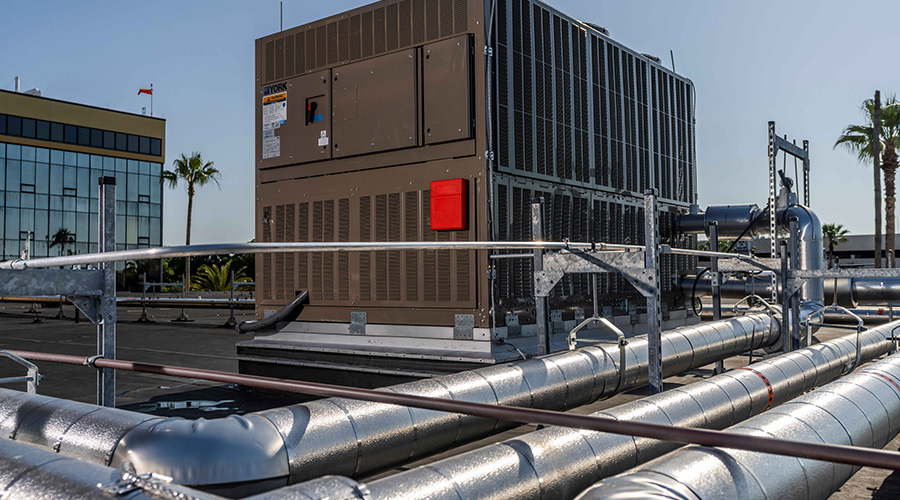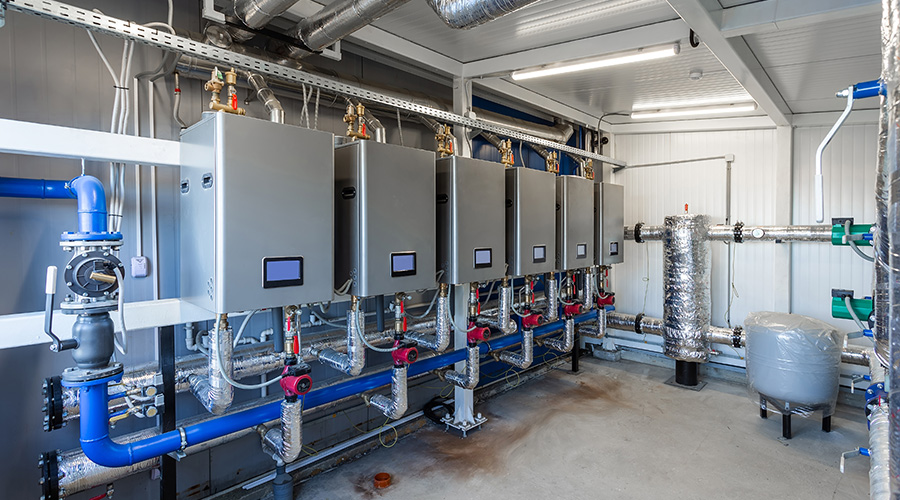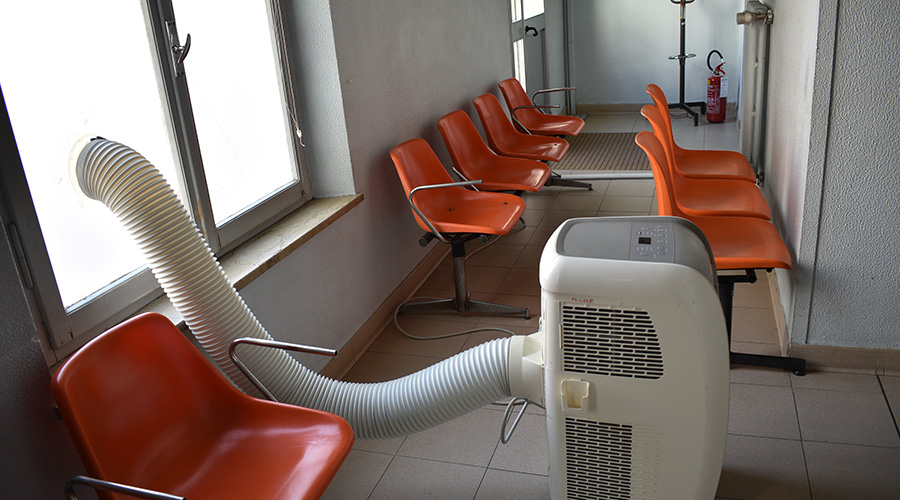Merrill Lynch Saves Now, Saves Later
Ice storage and low-temperature air distribution help the financial services giant trim both operating and construction costs
The recently completed Merrill Lynch campus is an example of the type of technology-driven facilities that are a complex challenge to design, construct and operate. These facilities house corporate office environments with a high density of computer, voice and data equipment. They must provide not only the amenities needed to recruit and retain high-level employees, but also a more extensive power and data infrastructure, as well as more robust mechanical and electrical systems to maximize uptime.
Simply achieving those goals isn’t enough. Especially in today’s economy, it’s important to find ways to reduce both construction and operating costs. A close look at the Merrill Lynch campus in Hopewell Township, N.J., shows ways to do just that: trim the cost of operating facilities while holding the line on first costs.
The 1.2-million-square-foot campus, located 40 miles north of Philadelphia, consists of four clusters of three buildings: a pair of office buildings grouped around a two-story assembly building that houses common spaces such as dining areas, training rooms, and fitness centers.
There are four satellite heating hot water and chilled water plants with low-temperature, variable volume air distribution. Each plant supplies chilled water and hot water to an assembly building and two adjacent office buildings. Air handling units are located in attic spaces of each of the eight office buildings.
A separate chilled water loop serves supplemental air-conditioning units in raised-floor areas.
Thermal Ice Storage
Thermal ice storage was coupled with low-temperature air distribution to create both initial and operating cost savings, as compared with a conventional mechanical system.
In the design of the HVAC system, life-cycle cost optimization was used to strike a balance among construction cost, energy efficiency, indoor air quality and comfort. This process used computerized energy simulation techniques to evaluate the economic feasibility of options.
When HVAC system choices were being evaluated, special attention was paid to reducing peak electrical demand, because demand charges are expected to rise faster than consumption charges. This was one factor that led to the selection of thermal ice storage, which lowers the demand component of electricity cost by shifting the time when power is used to create chilled water.
Thermal ice storage uses chillers during offpeak times (i.e., evenings) to cool a mixture of propylene glycol and water to 20 F, which is then circulated through coils inside a tank containing water to create ice. During the day, the process is reversed: the ice melts and cools the glycol/water mixture to 38 F. The 38 F glycol/water mixture is routed to cooling coils in air handling units, which generates 48 F supply air.
Air-conditioning is typically the largest power demand in commercial buildings and typically peaks in late afternoons in summer. Most buildings in an area peak at the same time, and electric utilities base generating capacity on meeting this peak.
Producing chilled water during offpeak times, when the electric utility’s power usage is lower, reduces the demand charge. It also benefits the electric utility because it utilizes generating capacity more during evening hours.
A hybrid configuration optimized the economics at the Merrill Lynch facility. The ice storage system contributes 40 percent of the chilled water demand during the day, with chillers satisfying the remainder of the demand directly. As a result, the chilled water plant capacity was downsized by about 40 percent relative to a conventional system, producing a significant construction cost savings.
To support the maximum-uptime goal of the campus, some chillers are backed up by on-site emergency power generators, which operate during a failure of the normal power supply. The cost savings associated with downsizing the chilled water plant capacity was amplified because the emergency generators were likewise reduced in capacity. The facility can “ride through” a two-hour power outage by taking chilled water from the ice storage system to maintain environmental conditions.
Chilled water from ice storage also supplies emergency cooling to several critical air-handling units and to supplemental air-conditioning units in raised-floor areas. Ice storage was selected rather than chilled water storage because it required less space.
The air distribution system sizing is driven by the air flow rate required by each zone. The supply air flow rate can be reduced when the supply air temperature is reduced; effectively, more energy is being extracted from the same amount of air.
Low-temperature Supply Air
At the Merrill Lynch site, the ice storage system allowed the chilled water supply temperature to be reduced and allowed a lower supply air temperature. This reduction in airflow rate translates into ductwork and fans being about 20 percent smaller than a conventional system, with proportional construction cost savings.
Compared to a more conventional 55 F system, the 48 F supply air temperature used at the Merrill Lynch facility produces annual operating savings by:
- Reducing fan power required to distribute air through the system, since the airflow rate is lower.
- Extending the duration of the economizer mode, in which the air handling units use outside air instead of mechanical refrigeration. Because the supply air temperature is lower, there are more hours available in which the economizer mode can satisfy the supply air temperature setpoint.
Overcoming Challenges
There are two major challenges in applying low-temperature air distribution systems. The first is that the 48 F air can cause complaints about drafts if it reaches occupants directly. The second concern is that condensation is more likely to occur on duct surfaces because the 48 F supply air temperature is much lower than the room dewpoint.
The solution to the first issue is to efficiently mix the 48 F supply air and the room air (e.g., 74 F) before the air reaches occupants. One way to do that is to use high-induction diffusers, which use jets to induce a mixing process between the supply air and the room air.
At Merrill Lynch, another option was selected: fan-powered variable volume boxes, which mix air from the return plenum (above the ceiling) and the low-temperature supply air to create a constant flow, variable temperature airstream.
The solution to the second problem is to provide continuous external insulation with a vapor barrier, even at “non-traditional” locations such as the return bends of hot water reheat coils.
The building automation system (BAS) plays a key role in sustaining the balance among indoor air quality, operating cost and occupant comfort. Standalone building automation systems serve each cluster of buildings and transmit alarms to a central workstation.
The BAS also takes advantage of the fact that air-handling units on each floor of the office buildings are interconnected.
The looped supply air ductwork allows some fans to be deenergized during evenings, weekends and other periods of partial occupancy; the remaining fans function in a more efficient operating range.
During offpeak times, the building automation system recognizes where occupants are located by light fixture usage, and only the VAV boxes serving those zones are allowed to open.
The BAS also monitors control systems for the supplemental air-conditioning units that supply the raised-floor spaces.
Commissioning of the BAS significantly increased reliability in this high-uptime facility. The control system vendor formally demonstrated that the BAS performed the sequence of operations, identified equipment failures and executed actions to respond to failure scenarios. System deficiencies were then resolved before occupancy.
Thomas Reed is a principal and director of projects at Kling, a national architecture, engineering, interiors and planning services firm headquartered in Philadelphia. Mark Maguire is engineering principal at the firm.
Reliability, Economy Drive Electrical Power System Design
A robust electrical power system is critical to maximizing uptime. The power distribution system on the Merrill Lynch Hopewell campus consists of a looped 26.4 kV site power distribution system with local (building-level) voltage reduction. A portion of the loop can be bypassed if it is damaged or down for maintenance, without disrupting service to the buildings.
What’s more, the 26.4 kV service voltage lowered the project cost because the sizing criteria for the higher voltage permitted smaller, less expensive conductors. And utility metering on each service at the switchgear are totalized to recognize diversity among buildings on site. Finally, the electrical distribution system has the potential for adding cogeneration in the future if the economics improve.
Keys to success
Critical elements of the strategy for reducing both construction and operating costs at Merrill Lynch:
- A chilled water system using thermal ice storage to shift power usage into the evening and therefore reduce peak demand.
- Low-temperature supply air distribution to reduce fan and ductwork sizing.
- Looped supply air ductwork to create off-hour flexibility in air handling unit operation.
- Maximizing the potential of the building automation system by commissioning it to verify that the correct sequence of operation is executed and the performance is optimized.
- A robust electrical power system.
Roads Not Taken
In addition to the systems that were selected, the following questions were explored:
- Should the four chilled water plants be cross-connected to provide lower-cost redundancy and support of low cooling loads? This approach was not pursued because of the extended payback period.
- What percentage of peak load should be handled by ice storage? The construction and operating costs were optimized when the ice storage system was sized for 40 percent of the peak chilled water demand.
- Should low-temperature supply air distribution be used without ice storage? This alternate was not recommended due to the extended payback period.
- Should direct natural gas-fired absorption chillers be used? Although the absorption chillers could simultaneously supply both chilled water and heating hot water, and therefore reduce the overall boiler capacity, this approach was not recommended because the low chilled water temperature required for low-temperature air distribution is at the low end of the range of absorption chiller capabilities. Instead, electric centrifugal chillers were used.
Related Topics:











